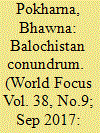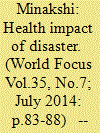|
|
|
Sort Order |
|
|
|
Items / Page
|
|
|
|
|
|
|
| Srl | Item |
| 1 |
ID:
154760


|
|
|
|
|
| Summary/Abstract |
The conflict in Baluchistan is protracted and extremely complex. Basically, the root causes of the conflict are both historical and political. Besides the historical and political reasons, the social factors such as ethnicity and religion has also played a vital role in the continuance of the conflict. Lack of representation at the decision-making level and low quotas for political representation are the prominent factors that have added more misery to the ongoing problems, thus spiraling this conflict out of control.
|
|
|
|
|
|
|
|
|
|
|
|
|
|
|
|
| 2 |
ID:
132500


|
|
|
|
|
| Publication |
2014.
|
| Summary/Abstract |
Gender and Health Issues in Disaster: Disasters are traumatic events that are experienced by many
people and may result in a wide range of mental and physical health consequences (Norris, Friedman,
Watson, et al., 2002). The resulting impacts from disasters are frequently more severe on women and
girls than those of their male counterparts and women's physical, reproductive and mental health needs, along with other facets of women's lives,.have largely been ignored in the whole process (Laska et al., 2008). According to WHO, there is pattern of gender differentiation at all level of disaster process: exposure ' to risk, risk perception, preparedness, response, physical impact, psychological impact, recovery and reconstruction and there is evidence showing that women and men may sufferdifferent negative health consequences after the disaster (WHO, 2002). However, it is not clear whether this is due to biological differences between the sexes, because of socially determined differences in women's and men's roles and status or because of the interaction of social and biological factors (WHO, 2002).
|
|
|
|
|
|
|
|
|
|
|
|
|
|
|
|
| 3 |
ID:
104051


|
|
|
|
|
| Publication |
2011.
|
| Summary/Abstract |
Most NATO countries reformed their defence systems during the 1990s in response to the end of the Cold War. Although Norway adjusted to new external framework conditions and participated in the new international operations, territorial defence dominated the defence discourse and military practices at home into the next millennium. This article argues that the continuity in the discourse and the pace with which defence reform has been implemented during the period 1990-2005 is a result of social factors and relations at the national level. First, the nation-building role of the Norwegian defence system has shaped central national concepts, values and military practices, rendering it resistant to change. Second, reform has been counteracted by the weight of the military institution - in terms of size, geographical extent and deep-rooted practices related to training and education. Third, Norwegian defence policy is deeply intertwined with other domestic policy areas, so when changes in the defence establishment have negative consequences, especially for district policy, opposition is provoked. In contrast, the Norwegian defence discourse and practices seem to have rapidly co-opted the changes invoked by the emerging multi-polar system. This underscores the claim made here, that the Norwegian defence discourse is largely about national, territorial defence.
|
|
|
|
|
|
|
|
|
|
|
|
|
|
|
|
|
|
|
|
|